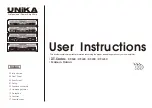
SUBWOOFER MODE :
This mode sends low frequencies to your speakers without the use of an external cross-over. The subwoofer operation can be operated in
stereo, parallel, or bridge mono modes. Change the different operating modes by flipping the mode switch on the rear of the unit to your desired operating mode. Also,
set the subwoofer mode switch to the “SUBWOOF” position. Use the frequency selector to adjust the subwoofer output frequency from 20Hz to 200Hz. The different
subwoofer modes are listed as follows:
Bridge Subwoofer -
This operation allows you to get the most possible power out of your amplifier for the sole purpose of running a high powered subwoofer
loudspeaker in mono. To avoid amplifier overheating, never run the amplifier below 4 ohms in this mode. In this mode you may use the frequency adjustment on the rear
of the amp, to control the frequency output level. Frequencies may be adjusted from 20Hz to 200Hz. Page 13 /
18 details a typical Bridge Subwoofer set up.
Figure
Stereo Subwoofer -
This operation is similar to the Bridge Subwoofer operation but in stereo. This operation allows you to run several subwoofers down to a minimum
of 2 ohms. To avoid amplifier overheating, never run the amplifier below 2 ohms in this mode. Set up this mode as you would a standard stereo set up. Be sure both
channels are set to “SUBWOOF.” In this mode you may use the frequency adjustment on the rear of the amp, to control the bass frequency output level. Frequencies
may be adjusted from 20Hz to 200Hz. Page 14 /
19 details a typical Stereo Subwoofer set up.
Figure
Parallel Subwoofer -
This operation is similar to the Stereo Subwoofer operation but in Parallel. When running subwoofers, it is usually recommended to run them in
mono mode to achieve a cleaner tighter low end. This operation allows you to run several subwoofers down to a minimum of 2 ohms. To avoid amplifier overheating,
never run the amplifier below 2 ohms in this mode. Set up this mode as you would a standard stereo set up. Be sure both channels are set to “SUBWOOF” and the mode
switch is set to “Parallel.” In this mode you may use the frequency adjustment on the rear of the amp, to control the bass frequency output level. Frequencies may be
adjusted from 20Hz to 200Hz.
One Channel Normal / One Channel Subwoofer (BI-AMP) -
You may also use your amp to bi-amp your system. You may use one side of the amp to power a
subwoofer and the other side to power a full range speaker. Follow the set up guides listed above to mix and match your operations.
page 13
Do Not Use
CH-2 Input
CH-1 Input
Set to
Subwoof
Negative (-) Lead
Positive (+) Lead
PARALLEL
STEREO
BRIDGE
XT-1250 Rear Panel
Bridge Subwoofer Mode Speaker Set-Up
Figure 18
Use the two red terminal from the Binding Post to
power a subwoofer speaker in mono-bridge mode.
Safety Precautions | Introduction | Front Panel | Rear Panel
Set Up
Speakon Assembly
|
|
|
| Protection | Amplifier Features | Specifications
Operating Modes
PARALLEL
STEREO
BRIDGE
SUB
WOOF
NORMAL
FREQUENCY
NORMAL
SUB
WOOF
FREQUENCY
20 Hz
20 Hz
200 Hz
200 Hz
INPUT BALANCE
INPUT THRU
PUSH TO RESET
BRIDGE
MONO
_
+
+
+
_
CH-1
CH-2
CH-2
CH-1
_
OUTPUTS
PINOUT
1+
1-
POS NEG
CH- 2
PINOUT
2+
2-
POS NEG
CH- 2
1+
2+
POS NEG
BRIDGE
1+
1-
POS NEG
CH- 1
CH-1
CH-2
CH-1
CH-2
GAIN
0.775V
26dB
32dB
Made in Taiwan
CAUTION
MINIMUM LOAD IMPEDANCE
2 OHM PER CHANNEL
4 OHM BRIDGE
input power less than 2000W
~220V 50Hz
UNiKA
XT-500 / XT-600 / XT-900 / XT-1250
Содержание XT-Series
Страница 19: ...page 18 UNiKA XT 500 XT 600 XT 900 XT 1250...
Страница 20: ...Professional Power Amplifiers UNiKA...






































